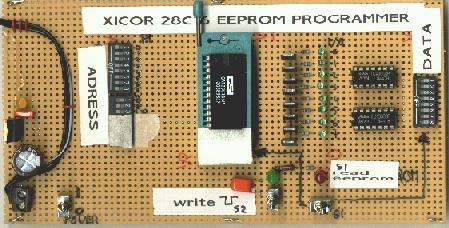

I also note that it seems to be missing its 74121 chip, that was presumably scavenged for some other urgent need. The socket with the wired jumpers labeled “J” allows the programmer to be reconfigured for the various sorts of EPROMS. FOR SALE A google check is usually the best way to find out if. (To generate more than 20v requires that I cascade the two independent sections of my lab power supply together.) MODULAR CIRCUIT TECHNOLOGY Eprom Programmer MOD-MEP NEW IN BOX.(C16B1).

The clip leads (red and black) are for connection to my lab power supply in order to provide that programming voltage. So, I propose here a small layout version of that circuit. Programmateur, eeprom, eprom, nv ram de 2Ko à 2MoMontage électronique, conception, circuit imprimé.inversion de polarités possible.faire un circuit imprimé p. However, for 2716 and up and programming voltage in the 20-26v range (depending upon the EPROM) is required. This is also an EEPROM programmer as it supports 12Cxx EEPROM. The power supply is based on an old Jameco JE200 +5V supply (which supplies power for the logic) with a JE205 multi-voltage board kit to provide the -5V and +12V necessary to program a 2708 EPROM. The power supply shown in the photograph is sufficient for programming 2708’s and provides some of the voltages for the other EPROMS, and connects via the square connector to the programmer board. It is designed to be driven from a parallel port on my Altair - but these days I might drive it from something like an Arduino if I wanted to use it. Later I also used it to program larger EPROMS for my Netronics PC.
Eprom programmer circuits full#
Back in the day I had a drawer full of Erasable Programmable Read-Only memory chips (EPROMs), as well as an EPROM eraser and programmer. This time it was, well, for fun and profit. The prototype of my Mk2 EPROM Programmer. The best part being absolutely no wiring. It uses a Lattice ispLSI2032 PLD to enable everything to fit on a single sided PCB. Lower cost than the Mk1 version, and 10 times easier to build. Gable that appeared in the Decmber 1978 issue of Byte magazine. Digital Circuits 6: An EPROM Emulator Digital Circuits 6: An EPROM Emulator. The design has fully automatic device ID detection, support for up to 2Mb 32 pin EPROM's.

The circuit is based on the magazine article “Zapper – A Computer Driven EROM Programmer” by G.H. The first EPROM programmer I constructed was built in order to program 27 EPROMS for my Altair.


 0 kommentar(er)
0 kommentar(er)
